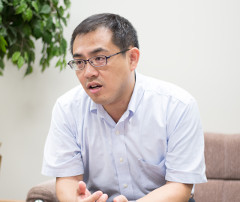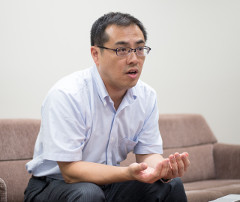The movement of LGBT rights in America accelerated in the 1960’s

In recent years, the terms, LGBT (Lesbian=homosexual woman, Gay=homosexual man, Bisexual=person who has sexual attraction to both genders, and Transgender=people who have a gender identity that differs from their gender designated at birth) and SOGI (Sexual Orientation and Gender Identification), have been often heard in Japan, and an understanding of sexual minorities seems to have increased. However, compared to the US, efforts by society toward LGBT rights are quite different in Japan.
The movement of LGBT rights began in earnest in the end of 1960’s in the US, although there was a series of homosexual rights movements even before that time. The Stonewall riots, in which a community of gay people clashed with police over a raid in 1969, sparked the gay liberation movement across the country. The site of the riots, the Stonewall Inn, is a gay bar in New York City. The Civil Rights Act had been enacted since 1964 in response to the movement against discrimination and the demand for equality for women and black people. To fight for homosexual rights, the gay liberation movement also campaigned along with various other social movements of the era, such as civil rights movements symbolizing black power and the women’s movement, and the anti-Vietnam War movement. These movements mutually affected one another, and they sometimes collaborated together. In line with this, the LGBT movement initially was geared more toward profoundly changing society based on the general idea that the real problem lies in a social system which disapproves of, or discriminates against, homosexuals. One example is the case of same-sex marriage. In recent years, same-sex marriage has come to be recognized as a symbol of the social acceptance of LGBT people, and in 2015, a U.S. Supreme Court ruling made same-sex marriage a right nationwide. However, at the beginning of the gay liberation movement, the gay community did not pursue same-sex marriage. Instead they maintained that the institution of marriage was a social system that discriminated against homosexuals and should therefore be destroyed. They opposed the institution of marriage because only a restricted group of people was eligible to participate in the institution that even imposed a limitation on the relationship and roles of its participants. The gay community believed two people who truly love each other could freely bond together only by dismantling the institution of marriage.
This trend began to change greatly after the 1980’s. As the so-called HIV/Aids moral panic emerged, and homosexuals became the target of criticism, a new movement to protest against discrimination of AIDS patients and homosexuals became active. Concurrently, some LGBT rights activists began attempting to proactively adjust to the existing values of society while demonstrating values of their own. LGBT groups appealed for benefits as a part of the consumer market using an approach called LGBT marketing. They asserted that participation by LGBT people could contribute to mainstream society through the contribution of their diversity and creativity and this would lead to the revitalization of society and businesses. It was during this time that same-sex marriage became an important equal rights agenda item. Those considered socially mainstream, people who are heterosexual and cisgender (people whose gender identity matches the gender that was designated at birth,) began feeling a sense of sympathy for homosexuals who were actively seeking the socially orthodox form of marriage, believing they could understand each other.
As shown above, the homosexual rights movement in the US has undergone some changes. Recent movements by major LGBT rights groups are to seek the same rights as cisgender, not special rights for LGBT people. These groups have been active in making their presence known as contributors to society based on the logic for efficiently spreading this concept in society.
The idea that “rights come with duties”
In recent years, in Japan, too, LGBT-friendly human-resources policies have been gaining attention from the perspective that LGBT marketing and diversity can promote creativity within a company. In fact, multiple major publishers have featured LGBT marketing in their business magazines. In some sense, a boom in LGBT is happening now. Some say LGBT has made progress in society in Japan because we see transgender celebrities on TV almost daily.
However, the LGBT liberation movement in the US is, basically, a rights movement, and for this purpose the benefits of LGBT people to society are strategically presented. Although the phenomena surrounding LGBT in Japan are similar to those in the US, Japanese people are less aware of human rights issues. For this reason, people recognized as LGBT who are able to contribute to mainstream society, comprised of heterosexual and cisgender people, can gain empathy from those mainstream people. However, sexual minorities who find it difficult to gain empathy from cisgender will be further alienated and forsaken, coming to live invisible existence. This tendency could become more apparent in Japan than the US.
This concern actually surfaced when a female Liberal Democratic Party (LDP) lawmaker made a problematic comment this past August. She claimed the government should not support LGBT people because they do not bear offspring and thus are not “productive” (“reproductive,” to be exact.) Seeing people completely as a resource of the government or society is a serious problem. But a more serious problem is her view that she approves of the rights of people who can benefit the government and society, but not the rights of the people who cannot. At the root of her view lies the pressure to force LGBT people to conform to the values that consider heterosexual and cisgender people as “ordinary” and “normal,” and behave as “others” in a way desired by mainstream society. This means only LGBT people who aid in the invigoration of markets and businesses, or who offer entertainment as clowns for society by showing society a cooperative attitude, can be accepted. Otherwise, no acceptance or rights will be granted in society.
Hierarchical relationship based on “compassion”

Criticism arose within the LDP against discriminatory comments made by the fellow member. One such criticism was that her comments were not suitable for an LDP that values compassion. Certainly, we often hear people say that cisgender, who form the majority of society, should reach out to LGBT people, who are sexual minorities in a vulnerable position. However, this idea is based on the hierarchical relationship in which LGBT take a backseat to cisgender. I think there is a tendency that people have no doubts or criticism about this logic in current Japanese society. Some argue Japan has had a culture tolerant to homosexuality since ancient times, and because of this, people are comparatively tolerant to LGBT even today. However, male homosexuality, which has been historically accepted in Japan, was, in fact, mostly based on hierarchical relationships. In other words, in many cases, it was not relationship of love based on an equal footing. I think Japanese people have been tolerant to a society which approves of the existence of people who fulfill their roles commensurate with the positions given to them according to the hierarchy of both the prewar and the postwar periods. Why are transgender celebrities accepted when they play the role of a clown? Why do people talk about “compassion” based on the hierarchical view of humans to deal with human rights issues? This is because of the logic that playing a role commensurate with a position based on hierarchy means fulfilling duties have been passed down without criticism or validation up to now.
Protection of LGBT human rights in the US is not necessarily perfect. Since Donald Trump assumed office, in particular, Evangelicals, a very conservative sect among Christian sects, has gained power, and anti-LGBT movements have intensified. On the other hand, there exist groups of people who confront such movements, and it looks like there are two societies in the US that hold completely different views, conflicting with each other.
Yet, values which are the backbone of American politics and culture give weight to freedom and equality for individuals. When people talk about minority issues in Japan, they often use the phrase, “consideration for the weak,” while in the US when they advocate for the rights of minorities, such as LGBT people, minorities are never referred to as “the weak.” Minorities are never inherently lesser people. Their claim is that they are treated unequally, deprived of power, and placed in a disadvantageous position by the laws and systems that help promote discrimination and inequality. The term, “the weak” may be used based on the assumption that minorities should be put under the majority with the idea of hierarchy.
Considering LGBT human rights provides an opportunity to change Japanese society
Considering discrimination against LGBT can also help find an issue common to discrimination against SOGI, as well as racial and ethnic minorities, people with disabilities and women. That is, the “minorities” who are discriminated against are created by the “majority,” or the “ordinary” and “normal” “majority” is established only by singling out certain groups of people and making them “abnormal” “minorities” as “others.”
Homosexuality had been regarded as an “illness” since the end of the 19th century in the US. However, in 1970’s, following a series of lectures on homosexual activities, the American Psychiatric Association changed its policy and homosexuality was no longer considered an “illness.” Although “transgender” was treated as an “illness” (called “gender incongruence” or “gender identity disorder”) for quite a while, this year, the WHO announced it would declassify transgender as a mental illness.
By regarding homosexuality or transgender as an “illness,” it had been defined that humans are classified as male or female at birth as the state in which gender identity matches gender classification at birth, and only people who desire people of the opposite gender are considered “normal.” However, this concept created and forced people to adapt a sense of value that a man born as a male should fulfill the specific role expected of a man and desire only a woman. In addition, likewise, a woman born as a female should conform to the role assigned to her as a woman and have a sexual relationship only with a man. As American society entered the 20th century, this trend emerged and intensified as a reaction to the era in which people, especially women, were expanding and diversifying their roles in society. Accordingly, in order to control a variety of lifestyles and views of identities of such men and women who actually existed or may exist, the group of those men and women were categorized into “abnormal minorities” whose existence is not bound by narrowly defined specific views of “masculinity” and “femininity.”
However, because of this, America has gone through changes since the 1960’s through various movements in which people have brought challenges to society. Like America, it is possible for us Japanese to make our society a better place to live by reexamining and changing our current society. Responsibility lies with the “majority” side. When viewing LGBT issues as human rights issues, we will be able to understand that they are not “someone else’s” issues but “ours.” In addition, that will trigger a review of and change in current society.
* The information contained herein is current as of October 2018.
* The contents of articles on Meiji.net are based on the personal ideas and opinions of the author and do not indicate the official opinion of Meiji University.
Information noted in the articles and videos, such as positions and affiliations, are current at the time of production.


